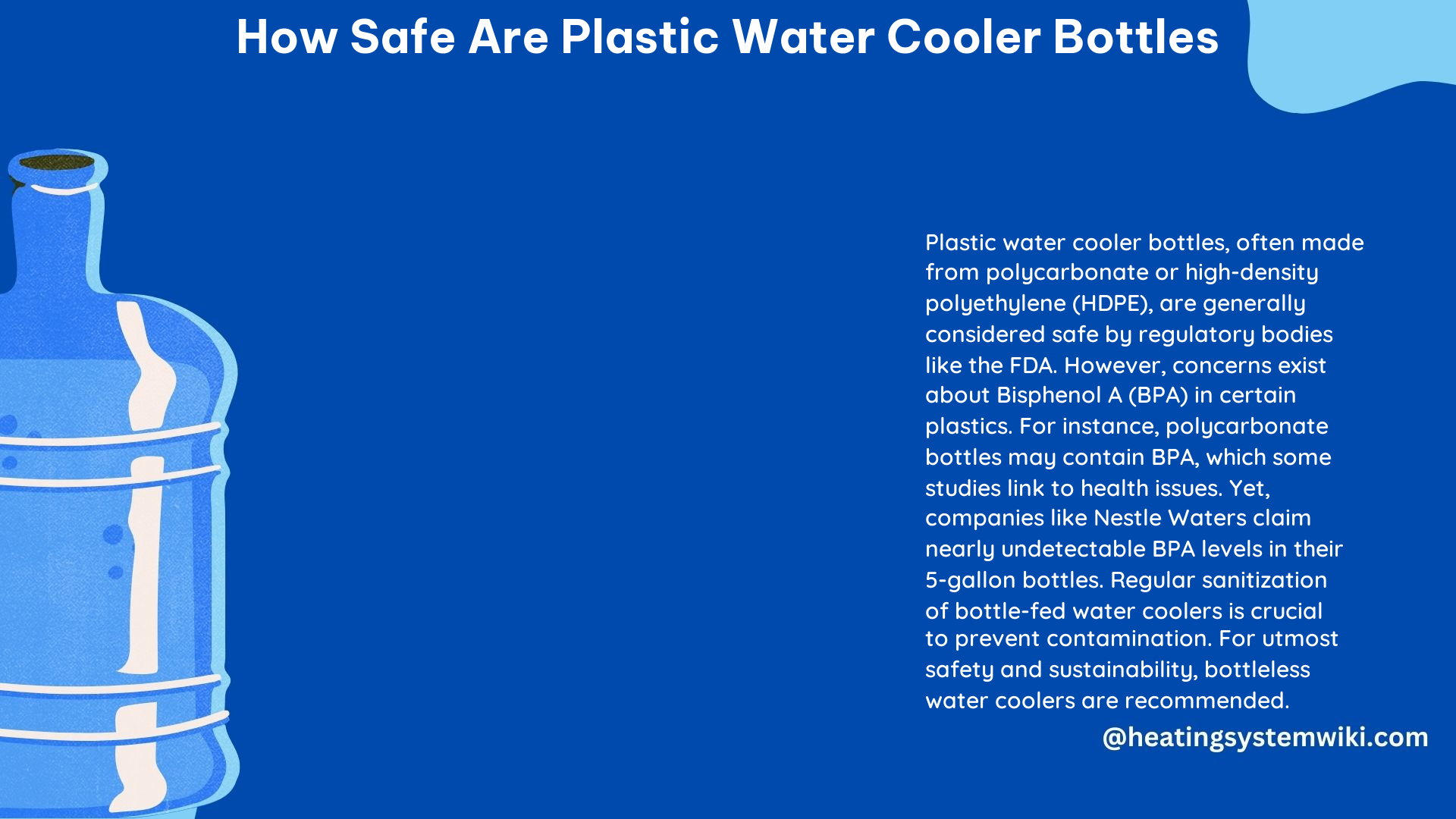Plastic water cooler bottles, while convenient, do pose some potential health risks. The two main dangers associated with these bottles are the source of the water and the possibility of toxins leaching into the water from the plastic.
Water Source Concerns
Regarding the water source, most plastic water bottles list a geographic source for the water they contain. However, many brands of bottled water are actually just glorified tap water, with no additional filtering or processing. This means that the water may contain contaminants or additives that are not present in tap water.
According to a study by the Natural Resources Defense Council, about 25% of bottled water is just repackaged tap water, with no additional treatment or purification [1]. This can lead to the presence of chlorine, fluoride, and other chemicals that are added to municipal water supplies.
Furthermore, the water source can also be affected by the storage and transportation conditions of the plastic bottles. Exposure to heat, sunlight, and other environmental factors can lead to the growth of bacteria and the leaching of chemicals from the plastic.
Plastic Composition Risks

The plastic used in water cooler bottles can also pose health risks. Plastic bottles are often made from polycarbonate, which is slightly air permeable and can pick up both bacteria and chemicals from the air. Over time, these contaminants can build up in the water, leading to potential health risks.
One of the most well-known chemicals associated with plastic bottles is BPA (bisphenol A). BPA is a chemical used in the production of some plastics, and it has been linked to a variety of health problems, including heart disease, diabetes, and breast cancer. While many companies have stopped using BPA in products intended for children, it is still used in some plastic water bottles.
According to the FDA, the safe daily intake of BPA is 50 micrograms per kilogram of body weight [2]. However, studies have shown that exposure to BPA, even at low levels, can have adverse health effects, particularly in children and pregnant women.
Another potential health risk associated with plastic water bottles is the ingestion of microplastics. These are small pieces of plastic that can break off from the bottle and end up in the water. While the health risks associated with microplastics are not yet fully understood, there is evidence to suggest that they can be harmful to human health.
A study by the World Health Organization found that microplastics have been detected in various water sources, including bottled water, tap water, and even in human stool samples [3]. The long-term effects of microplastic ingestion are still being investigated, but they have been linked to inflammation, oxidative stress, and potential disruption of the endocrine system.
Alternatives to Plastic Water Cooler Bottles
To reduce the risks associated with plastic water cooler bottles, it is recommended to use a water purification system such as a bottleless water cooler. These systems provide a fresh, pure, and oxygenated water that is cost-effective and easily accessible. They also eliminate the need for plastic bottles, reducing the environmental impact of water consumption.
Bottleless water coolers use a multi-stage filtration system to remove contaminants, including chlorine, lead, and microorganisms, from the water supply. They also provide a continuous supply of water, eliminating the need for frequent bottle replacements.
According to a study by the Environmental Protection Agency, bottleless water coolers can reduce the carbon footprint of water consumption by up to 54% compared to traditional bottled water [4]. This is due to the elimination of the energy and resources required for the production, transportation, and disposal of plastic bottles.
DIY Steps to Reduce Risks
To further reduce the risks associated with plastic water cooler bottles, consider the following DIY steps:
-
Use a Water Purification System: As mentioned, a bottleless water cooler is an excellent alternative to plastic water cooler bottles. These systems provide a reliable and safe source of drinking water.
-
Regularly Clean and Sanitize the Water Cooler: Proper maintenance of the water cooler is essential to prevent the growth of bacteria and the buildup of contaminants. Follow the manufacturer’s instructions for cleaning and sanitizing the unit.
-
Store Replacement Bottled Water Properly: If you must use plastic water cooler bottles, store them in a cool, clean, and dark environment to minimize the exposure to heat, light, and air.
-
Consider Alternative Water Bottle Materials: Instead of plastic, consider using glass or stainless steel water bottles, which are less prone to leaching chemicals and microplastics.
-
Stay Informed: Educate yourself on the potential health risks associated with plastic water bottles and make informed decisions about your water consumption. Stay up-to-date with the latest research and regulations regarding the safety of plastic water bottles.
By following these DIY steps and considering the use of a water purification system, you can significantly reduce the risks associated with plastic water cooler bottles and ensure a safer and healthier drinking experience.
References:
- Natural Resources Defense Council. (2018). “Bottled Water: Pure Drink or Pure Hype?” https://www.nrdc.org/stories/bottled-water-pure-drink-or-pure-hype
- U.S. Food and Drug Administration. (2022). “Bisphenol A (BPA): Use in Food Contact Application.” https://www.fda.gov/food/food-additives-petitions/bisphenol-bpa-use-food-contact-application
- World Health Organization. (2019). “Microplastics in Drinking-water.” https://www.who.int/publications/i/item/9789241516198
- U.S. Environmental Protection Agency. (2020). “Bottleless Water Coolers: A Sustainable Alternative to Bottled Water.” https://www.epa.gov/sites/default/files/2020-01/documents/bottleless-water-coolers-sustainable-alternative-bottled-water.pdf
